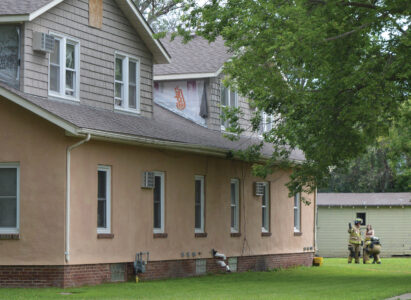MPS district ‘breaking even’ for the year
MARSHALL — Marshall Public School Business Director Dion Caron gave the annual Truth in Taxation presentation at the work session meeting on Monday at Marshall Middle School, revealing that the total 2019 proposed property tax levy will only slightly increase from 2018 — by $9,923.71 or .15 percent.
The school board will be asked to certify the total proposed school tax levy of $6,754,168.55 at its regular meeting on Dec. 17.
“The overall levy is only increasing .15 percent, so we’re basically breaking even for the year,” Caron said.
Minnesota’s Truth in Taxation Law requires that cities, counties and school districts follow certain steps before adopting a tax levy for the following year. School districts are required to hold a single meeting in which the budget and levy are discussed and the public is given an opportunity to speak and ask questions.
Schools are also required to explain the reasons for a levy increase or decrease. Caron pointed to a General Fund Levy change (-$26,849) for the Local Optional and board-approved levy.
“The reason for the decrease is due to the uncertainty of the funding for Voluntary pre-kindergarten,” Caron said. “We did not include the VPK number in our ADM (average daily membership) count for 2019-20, and 2019-20 is the enrollment number used in calculation for the Payable 2019 levy. The Local Optional and board-approved levy is $724 per ADM.”
There was also a negative change ($4,934) in the Community Service Levy for Early Childhood Family Education.
“Net tax capacity (NTC) is used in the formula to calculate this portion,” Caron said. “The 2017 net tax capacity, which is used for Payable 2019, was lower than the 2016 NTC amount.”
The final explanation comes from the Debt Service Levy change ($53,397) in debt excess.
“The reason for the increase is mainly due to us not reducing our debt excess in Payable 2019, which unless used, will be a decrease in Payable 2020,” Caron said.
All school district budgets are divided into separate funds, as required by law. MPS has six funds: General, Food Service, Transportation, Community Service, Capital Outlay and Debt Service.
In a comparison of 2017-18 actual and 2018-19 original budget (the one the board approved in June), the most noticeable was a 27.73 percent increase in the Capital Outlay fund.
“Everything is pretty much in line except for Capital Outlay,” Caron said. “That’s the 1:1 technology as well as some of our LTFM (long-term facilities maintenance) projects.”
Likewise, the biggest change in expenditures from a year ago is a 55.62 percent increase in Capital Outlay.
The largest part of the 2018-19 budget revenue is General fund (74 percent), followed by Debt Service (8 percent), Community Service (6), Capital Outlay (4), Transportation (4) and Food Service (4).
As expected, the majority of General fund revenues come from the state (81 percent for 2018-19).
“Only 11 percent comes from property tax,” Caron said.
Other local sources make up 4 percent, while 2 percent comes from federal sources as well as from tuition and contracts.
“Comparing 18-19 to 17-18, the percentages haven’t really changed at all,” Caron said.
The General fund expenditures by program show that regular instruction accounts for 47.68 percent, followed by special education (20.03 percent), sites and buildings (9.57), instructional support (7.50), pupil support (5.11), administration (4.35), district support services (3.43), vocational instruction (2.01) and fiscal and other (0.32).
“We are in the business of teaching people, so this is pretty typical of school districts,” Caron said.
MPS Superintendent Scott Monson said between regular instruction, special education, instructional support and vocational instruction, 77 percent of the General fund expenditures go directly into the classroom.
“Years ago, there was some discussion about the threshold being 70 percent,” Monson said. “School districts need to illustrate that 70 percent or more of your expenditures were going into the classroom, so that’s pretty good.”
When asked by board member Matt Coleman, Caron explained that pupil support includes staff such as nurses and library assistants.
Salaries (65.36 percent) and benefits (19.52 percent) make up the bulk of the General fund expenditures when broken down by object. Also included are: purchased services (10.76 percent), supplies and materials (2.71), equipment (1.41) and other expenditures (0.25).
“The majority of our expenditures are going to be salaries and benefits,” Caron said. “It’s almost 85 percent of our budget, which is also typical of all school districts.”
Caron also broke down the key steps in the process of determining property taxes. After the city or county assessor determines the estimated market value for each parcel of property in the county, the Legislature sets the formulas for tax capacity.
The county auditor then calculates the tax capacity for each parcel, followed by the Legislature setting the formulas which determine school district levy limits and the Minnesota Department of Education calculating detailed levy limits for each school district, based on the formulas approved by the Legislature.
The only step that involves school districts is Step 6: the school board adopts a proposed levy in September, based on the limits set in Step 5. After a public hearing, the board adopts a final levy in December.
“Any of these steps may affect the taxes on a parcel of property, but the district has control over only 1 of the 7 steps,” Caron said. “We input the enrollment numbers and the board approves the maximum levy amount in September. We have very limited control over the process.”
The final step involves the county auditor dividing the final levy by the district’s total tax capacity to determine the tax rate needed to raise the proper levy amount. The auditor multiples the tax rate times each property’s tax capacity to determine the school tax for that property.
“If your (school) taxes are going up, it’s probably because the estimated market value is going up,” Caron said. “We don’t have any control over that.”



